
Reginald Denny (1891-1967)
With the Royal Flying Corps
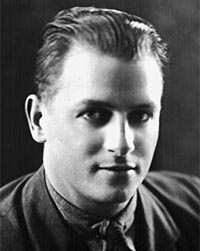 Introduction
Introduction
This page deals with Reginald Denny's wartime service with the Royal Flying Corps then Royal Air Force 1917-19.
Various sources so far examined quote conflicting information. Each is the subject of continuing research
What is known for certain is that Reginald Denny was in the Royal Flying Corps and was wounded most probably as the result of 'friendly fire' from his own AAA
Claim 1 : Reginald Denny served with 112 Squadron RFC during World War I
"After World War I service as a Lieutenant in the 112th Squadron of the British (Royal) Flying Corps, Reginald Denny...." http://shopping.yahoo.com
Editor
"112 Squadron was formed on July 30, 1917 out of 'B' Flight of 50 squadron as a Home Defence fighter unit to defend London and the south east corner of England against German bomber raids from bases in Belgium. 112 Squadron was was disbanded on June 13, 1919, having re-equipped with Sopwith Snipes shortly before." http://www.hotel.wineasy.se
Reginald Denny Jr. writes 11/02
"...to my knowledge, dad was never attached to 112 Squadron". (He was) "a gunner in a two seat aircraft" (and) "never flew a Snipe".
Conclusion
As 112 Squadron flew single seat fighters Sopwith Pups, Camels and Snipes and the authoritative book on 112 Squadron by Robin Brown Shark Squadron; History of 112 Squadron 1917-1975, does not mention the names Denny (or Dugmore), we can safely presume that the stated service with 112 Squadron is erroneous.
Claim 2 : Reginald Denny did not see active service
"Denny toured (theatrically) until 1917 when he went to New York to enlist with the Royal Flying Corps. Stationed in Hastings, England, the war ended before he completed his training." http://www.silentsmajority.com
Editor
This does not quite ring true. Even if Reginald Denny enlisted very late into 1917 the war would continue for at least 12 months or so. As I cannot see the primary military training (and later flight training) taking more than several months, he would still have had to have seen at least six to eight months of active service plus potentially another six months after the ceasefire
Reginald Denny Jr. writes 11/02
"I don't know that dad actually saw any combat during WW-1. He was attached to ground forces first, then attended flight school and served with the RFC as an aerial gunner."
"If my memory serves me, dad explained the war ended about the time he finished his pilots training. (During this time however)...he was wounded by his own AAA"..."Dad explained to me, in those days during night air attacks, British aircraft would fly into a German squadron blink their lights and get the hell out of the way Immediately thereafter.
British AAA would immediately begin firing toward the area where they had seen the lights blink. Dad said he was hit because his pilot didn't maneuver out of harm's way fast enough."..."During a conversation years later however, if recall correctly, dad told me this actually occurred during a practice training mission. Nonetheless the results were the same. Dad took some shrapnel in his side."
Editor
A Brief History of the RAF states..."Another area that was in need of massive improvement, and for which Sir Hugh Trenchard was primarily responsible, was training. During the First World War pilots had arrived at front-line airfields often with less than 20 hours total flying time. Operational losses were very high, particularly for these novice pilots but training accidents too took an unacceptably heavy toll. The life expectancy for a front-line pilot was six weeks, but most novices were killed in their first or second sortie."
Conclusion
We can presume that Denny did see some form of active service
So what did Reginald Denny really do in World War 1
Based on the above and supplementary reading, this editor currently believes that the story went like this...
Reginald Denny, a successful stage actor and possibly by then film actor, though no films with Denny mentioned are listed before 1919, enlisted with the British Royal Flying Corps in late 1917 in New York.
He sailed to the Britain in late 1917 or early 1918 and was posted to the airfield at Hastings in Kent in the southeast of England.
Reginald Denny completed his pilots training and was posted to either Squadron 39 or 141 as a 'gunner'. Both squadrons flew 2 seater Bristol Fighter F2Bs on home defence c.1917/18. http://www.raf.mod.uk
He was injured whilst on a night training mission and was repatriated home to the USA after recouperation in England.
Night flying in 1918 without the use of modern navigational instruments, radar and wireless would have been a harrowing task. Finding black painted bombers in the equal black of night then giving several flashes of an Aldis light to alert the gunners below to start shooting where the light had been seen calls for some form of admiration.
Rank and Decorations
On August 18, 2003 the Editor received the following specialist information from Hylton Routledge regarding the specific badges etc. worn by Denny in the following images. The information has been used to amend the citations on each image.
Dear Sir,
I have just found your excellent site and would like to offer a little help in one area. It is probably worth me just giving a quick introduction of myself first. I am collector and researcher of Royal Flying Corps (RFC), Royal Naval Air Service (RNAS) and Royal Air Force (RAF) militaria, including uniforms, insignia and contemporary photographs relating to that field.
The specific reason for the email, is to help you narrow down when the photos of Reginald Denny were taken. The uniform that he is wearing is a Royal Air Force one and not a Royal Flying Corps one. Although the photographs are in black and white, it is possible to ascertain that the colour of the uniform will have been Khaki. This being the first colour that the RAF wore following its formation on 1st April 1918. Additionally it is to be noted that the rank signified on the tunic, by means of the "bird and crown" is for 2nd Lt. not Lt., this particular designation changed in December 1918. Another clue that helps pinpoint the date of the photos lies within the type of hat worn, the style indicates that is was post late October 1918.
Therefore if Denny was up to date with having his alteration done to his uniform the photo should have been taken between late October and mid December 1918. This dating could well be supplemented when Denny's record of service has been examined as it will give the date of his promotion to (full) Lt.
Note that the cap badge shown is therefore also Royal Air Force rather than RFC. It is a very distinctive type of "Officer's Cap Badge" manufactured by J.R.Gaunt of London as early as April 1918. There should be a makers plate on the reverse of this particular badge. The sleeve insignia is again RAF not RFC, however in this instance I would say that the two piece badge shown is not of that period and guess that it has been added for illustrative purposes, but could not be 100% certain without seeing the reverse.
Please feel free to seek clarification on any of the above and I do hope that this helps a little to your project.
Best Wishes,
Hylton Routledge,
England.
Website of RFC, RNAS and RAF militaria;
http://www.routledgeh.freeserve.co.uk/index.htm
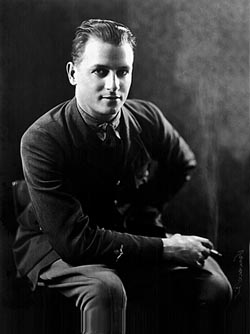
2nd Lt., Reginald Denny, Royal Air Force
Photo by 'Packard' of New York
Hylton Routledge notes that this photo was most likely taken between late October and mid December 1918
download a 500pixel image
The Denny Family Archives
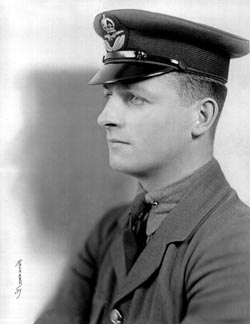
2nd Lt., Reginald Denny, Royal Air Force
Photo by 'Packard' of New York
Hylton Routledge notes that this photo was most likely taken between late October and mid December 1918
download a 500pixel image
The Denny Family Archives
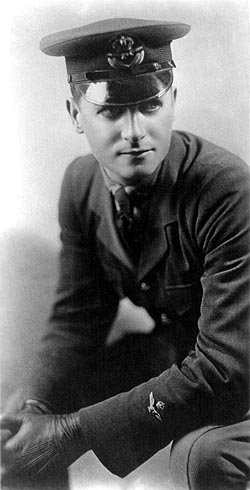
2nd Lt., Reginald Denny, Royal Air Force
Photo by 'Packard' of New York
Hylton Routledge notes that this photo was most likely taken between late October and mid December 1918
download a 750pixel image
The Denny Family Archives
Note the insignia worn on the cap and sleeves in the previous two images
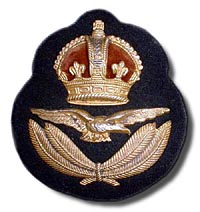
'Officer's Cap Badge', Royal Air Force
Hylton Routledge notes that this badge was manufactured by J.R. Gaunt of London as early as April 1918
The Denny Family Archives
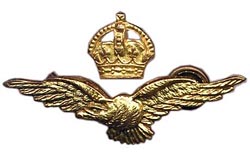
Sleeve Insignia, Royal Air Force
Hylton Routledge notes "I would say that the two piece badge shown is not of that period and guess that it has been added for illustrative purposes, but could not be 100% certain without seeing the reverse."
Courtesy http://www.jkmilitaria.com/
A Tale of a Snipe
"The [Canadian War] museum Snipe was made in 1918 [and] imported into the United States by actor Reginald Denny (an ex-RFC pilot), it was used in one or more movies then subsequently displayed in California before being restored and flown in 1960. After display at the United States Air Force Museum, it was purchased by the Canadian War Museum" http://www.aviation.nmstc.ca
Reginald Denny Jr. writes (11/02)
Actually my father brought three Sopwith Snipes into this country. Two were used in movies and crashed. The third was left on display at the Los Angeles Museum and was kept in near perfect condition. During 1952 the L.A. Museum advised dad they no longer had room for the plane and he should make arrangements to have it removed.
My father ignored this notice and the plane was sent to the Ontario Airport east of Los Angeles where it was left to rot in the weather. Sometime during the sixties a WW-1 aircraft buff by the name of Jack Canary discovered the rotting plane and using funds from the Airforce Association restored it to better than new, flyable condition....he even went to England and received information and permission to use the original insignia from the squadron to which the Snipe was attached.
When Canary attempted to find a home for the plane and receive reimbursement of the money he personally invested, he found he was unable to do so because my father still held title. My father signed over the title and The Museum of Aviation in Canada paid Canary $25,000.00 for the plane which covered Mr. Canary's personal cash outlay. At the time, this was the only flyable Sopwith Snipe remaining in the world. I believe another has since been put together somewhere.
Sopwith Snipe E6938 Gallery
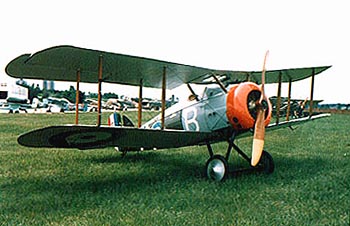
Sopwith Snipe E6938
Source : Canadian Museum of Aviation
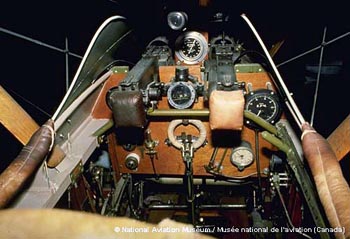
Sopwith Snipe E6938, cockpit detail
Source : Canadian Museum of Aviation
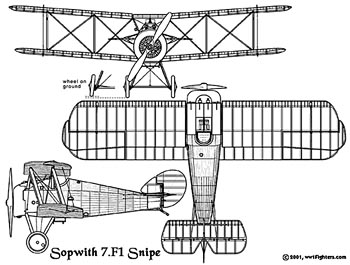
Sopwith Snipe 7.f1, 3View
download a 1000 pixel image
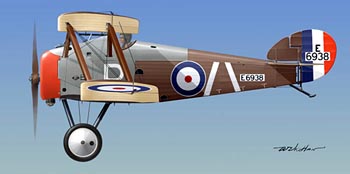
Sopwith Snipe E6938
Source : http://aviart.tcel.com
Notes with the above image say ..."Sopwith 7F-1 Snipe E6938, No. 1 SQUADRON (N0. 81 Sqdn. (Canadian) RAF) Formed in November 1918 England as a scout (fighter) unit, the Squadron flew training ops until February 1920".
also...somewhat conflicting ..."No. 81 Squadron was formed on January 7, 1917 at Gosport as a training unit but was not mobilised before being disbanded on 4 July 1918."
Read more about the history of the Royal Canadian Air Force
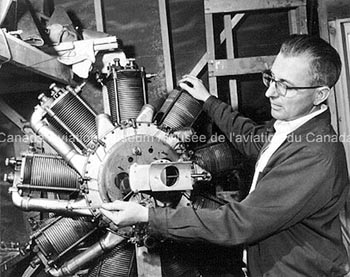
Jack Canary
Source : Canadian Museum of Aviation
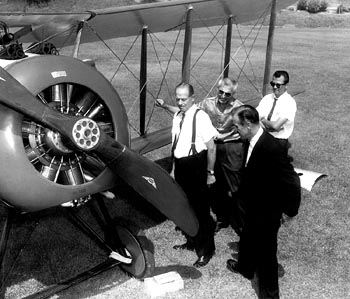
Jack Canary's restored Sopwith Snipe E6938
L to R: Reginald Denny, Jack Canary, Clete Roberts newscaster and WW-1 aircraft buff (in the dark suit) and at far right Reginald Denny Jr.,
download a 1500pixel image
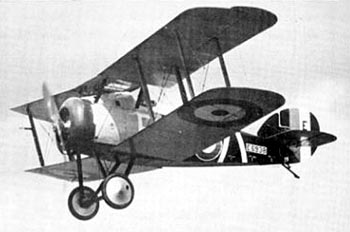
Jack Canary's restored Sopwith Snipe in flight, 1960s
Source : Canadian Museum of Aviation
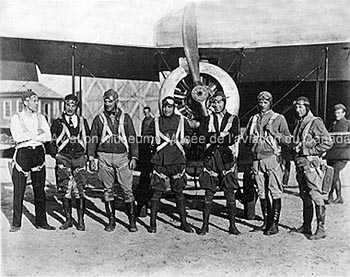
Ralph Douglas, Leo Norris, Frank Clarke, James Hall,
Ben Lyon, Frank Tomich, Roy Wilson
Source : Canadian Museum of Aviation
Although the aircraft in the above image is not identified it is more that likely to be one of the three Snipes imported by Denny and flown by these pilots from the Black Cats in movies such as Wings, and The Dawn Patrol.
Top | Reginald Denny Home
| 













 Introduction
Introduction